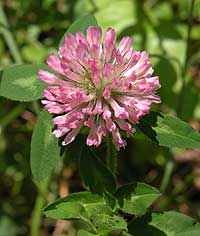 Red Clover
Red Clover
Trifolium pratense L.
Common Names
Red clover, broadleaved clover, cleaver grass, common clover,
common red clover, cow clover, meadow clover, purple clover,
sweet clover.
Description
Trifolium pratense L., red clover, is a biennial
or short-lived perennial legume, with long-petioled, tri-foliolate
leaves that grows as one of two types: medium (double-cut)
or mammoth (single-cut). The plants grow from crowns and have
hollow, hairy stems and branches. Stem lengths of medium and
mammoth types average 18 inches and 224 to 30 inches, respectively.
Medium types have about 4 branches per stem; mammoth have 6.
Each leaf consists of a slender stalk bearing 3 oval-shaped leaflets.
The taproot of red clover is extensively branched. Flowers are
born in dense clusters or heads and are usually rose-pink in color.
See pods are small, short, and contain kidney-shapped seeds that
vary in color from yellow to deep violet. Mammoth red clover matures
later than medium types; only one crop of mammoth red clover is
harvested each season since recovery is slow.
Flowering Period
May to September
Habitat
Roadsides, clearings, turf, fields, and meadows.
Harvest
Flowers and herb.
Uses
Red clover is primarily used for hay, pasture, silage, and
soil improvement. It is a quick growing crop, easily
extablished, and produces high quailty forage.
The flowers of this plant are therapeutically used as an antispasmodic, expectorant, sedative, and vulnerary. They are valued for the delicate sweet flavor they impart to herbal teas; and they combine expecially well with dried rose hips, lemon, and mint. In central Europe, clover has been used to regulate digestive functions, to improve the appetite, and to treat liver ailments.